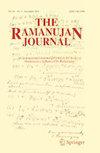下载PDF
{"title":"“穷人的ad<e:1>圈”中的非理性与超越问题。","authors":"Florian Luca, Wadim Zudilin","doi":"10.1007/s11139-025-01132-4","DOIUrl":null,"url":null,"abstract":"<p><p>We discuss arithmetic questions related to the 'poor man's adèle ring' <math><mi>A</mi></math> whose elements are encoded by sequences <math> <msub><mrow><mo>(</mo> <msub><mi>t</mi> <mi>p</mi></msub> <mo>)</mo></mrow> <mi>p</mi></msub> </math> indexed by prime numbers, with each <math><msub><mi>t</mi> <mi>p</mi></msub> </math> viewed as a residue in <math><mrow><mi>Z</mi> <mo>/</mo> <mi>p</mi> <mi>Z</mi></mrow> </math> . Our main theorem is about the <math><mi>A</mi></math> -transcendence of the element <math> <msub><mrow><mo>(</mo> <msub><mi>F</mi> <mi>p</mi></msub> <mrow><mo>(</mo> <mi>q</mi> <mo>)</mo></mrow> <mo>)</mo></mrow> <mi>p</mi></msub> </math> , where <math> <mrow><msub><mi>F</mi> <mi>n</mi></msub> <mrow><mo>(</mo> <mi>q</mi> <mo>)</mo></mrow> </mrow> </math> (Schur's <i>q</i>-Fibonacci numbers) are the (1, 1)-entries of <math><mrow><mn>2</mn> <mo>×</mo> <mn>2</mn></mrow> </math> -matrices <dispformula> <math> <mrow> <mtable> <mtr> <mtd> <mrow> <mfenced> <mrow> <mtable> <mtr><mtd><mn>1</mn></mtd> <mtd><mn>1</mn></mtd> </mtr> <mtr> <mtd><mrow><mrow></mrow> <mn>1</mn></mrow> </mtd> <mtd><mn>0</mn></mtd> </mtr> </mtable> </mrow> </mfenced> <mfenced> <mrow> <mtable> <mtr><mtd><mn>1</mn></mtd> <mtd><mn>1</mn></mtd> </mtr> <mtr> <mtd><mrow><mrow></mrow> <mi>q</mi></mrow> </mtd> <mtd><mn>0</mn></mtd> </mtr> </mtable> </mrow> </mfenced> <mfenced> <mrow> <mtable> <mtr><mtd><mn>1</mn></mtd> <mtd><mn>1</mn></mtd> </mtr> <mtr> <mtd><mrow><mrow></mrow> <msup><mi>q</mi> <mn>2</mn></msup> </mrow> </mtd> <mtd><mn>0</mn></mtd> </mtr> </mtable> </mrow> </mfenced> <mo>⋯</mo> <mfenced> <mrow> <mtable> <mtr><mtd><mn>1</mn></mtd> <mtd><mn>1</mn></mtd> </mtr> <mtr> <mtd><mrow><mrow></mrow> <msup><mi>q</mi> <mrow><mi>n</mi> <mo>-</mo> <mn>2</mn></mrow> </msup> </mrow> </mtd> <mtd><mn>0</mn></mtd> </mtr> </mtable> </mrow> </mfenced> </mrow> </mtd> </mtr> </mtable> </mrow> </math> </dispformula> and <math><mrow><mi>q</mi> <mo>></mo> <mn>1</mn></mrow> </math> is an integer. This result was previously known for <math><mrow><mi>q</mi> <mo>></mo> <mn>1</mn></mrow> </math> square free under the GRH.</p>","PeriodicalId":54511,"journal":{"name":"Ramanujan Journal","volume":"67 4","pages":"88"},"PeriodicalIF":0.7000,"publicationDate":"2025-01-01","publicationTypes":"Journal Article","fieldsOfStudy":null,"isOpenAccess":false,"openAccessPdf":"https://www.ncbi.nlm.nih.gov/pmc/articles/PMC12177006/pdf/","citationCount":"0","resultStr":"{\"title\":\"Irrationality and transcendence questions in the 'poor man's adèle ring'.\",\"authors\":\"Florian Luca, Wadim Zudilin\",\"doi\":\"10.1007/s11139-025-01132-4\",\"DOIUrl\":null,\"url\":null,\"abstract\":\"<p><p>We discuss arithmetic questions related to the 'poor man's adèle ring' <math><mi>A</mi></math> whose elements are encoded by sequences <math> <msub><mrow><mo>(</mo> <msub><mi>t</mi> <mi>p</mi></msub> <mo>)</mo></mrow> <mi>p</mi></msub> </math> indexed by prime numbers, with each <math><msub><mi>t</mi> <mi>p</mi></msub> </math> viewed as a residue in <math><mrow><mi>Z</mi> <mo>/</mo> <mi>p</mi> <mi>Z</mi></mrow> </math> . Our main theorem is about the <math><mi>A</mi></math> -transcendence of the element <math> <msub><mrow><mo>(</mo> <msub><mi>F</mi> <mi>p</mi></msub> <mrow><mo>(</mo> <mi>q</mi> <mo>)</mo></mrow> <mo>)</mo></mrow> <mi>p</mi></msub> </math> , where <math> <mrow><msub><mi>F</mi> <mi>n</mi></msub> <mrow><mo>(</mo> <mi>q</mi> <mo>)</mo></mrow> </mrow> </math> (Schur's <i>q</i>-Fibonacci numbers) are the (1, 1)-entries of <math><mrow><mn>2</mn> <mo>×</mo> <mn>2</mn></mrow> </math> -matrices <dispformula> <math> <mrow> <mtable> <mtr> <mtd> <mrow> <mfenced> <mrow> <mtable> <mtr><mtd><mn>1</mn></mtd> <mtd><mn>1</mn></mtd> </mtr> <mtr> <mtd><mrow><mrow></mrow> <mn>1</mn></mrow> </mtd> <mtd><mn>0</mn></mtd> </mtr> </mtable> </mrow> </mfenced> <mfenced> <mrow> <mtable> <mtr><mtd><mn>1</mn></mtd> <mtd><mn>1</mn></mtd> </mtr> <mtr> <mtd><mrow><mrow></mrow> <mi>q</mi></mrow> </mtd> <mtd><mn>0</mn></mtd> </mtr> </mtable> </mrow> </mfenced> <mfenced> <mrow> <mtable> <mtr><mtd><mn>1</mn></mtd> <mtd><mn>1</mn></mtd> </mtr> <mtr> <mtd><mrow><mrow></mrow> <msup><mi>q</mi> <mn>2</mn></msup> </mrow> </mtd> <mtd><mn>0</mn></mtd> </mtr> </mtable> </mrow> </mfenced> <mo>⋯</mo> <mfenced> <mrow> <mtable> <mtr><mtd><mn>1</mn></mtd> <mtd><mn>1</mn></mtd> </mtr> <mtr> <mtd><mrow><mrow></mrow> <msup><mi>q</mi> <mrow><mi>n</mi> <mo>-</mo> <mn>2</mn></mrow> </msup> </mrow> </mtd> <mtd><mn>0</mn></mtd> </mtr> </mtable> </mrow> </mfenced> </mrow> </mtd> </mtr> </mtable> </mrow> </math> </dispformula> and <math><mrow><mi>q</mi> <mo>></mo> <mn>1</mn></mrow> </math> is an integer. This result was previously known for <math><mrow><mi>q</mi> <mo>></mo> <mn>1</mn></mrow> </math> square free under the GRH.</p>\",\"PeriodicalId\":54511,\"journal\":{\"name\":\"Ramanujan Journal\",\"volume\":\"67 4\",\"pages\":\"88\"},\"PeriodicalIF\":0.7000,\"publicationDate\":\"2025-01-01\",\"publicationTypes\":\"Journal Article\",\"fieldsOfStudy\":null,\"isOpenAccess\":false,\"openAccessPdf\":\"https://www.ncbi.nlm.nih.gov/pmc/articles/PMC12177006/pdf/\",\"citationCount\":\"0\",\"resultStr\":null,\"platform\":\"Semanticscholar\",\"paperid\":null,\"PeriodicalName\":\"Ramanujan Journal\",\"FirstCategoryId\":\"100\",\"ListUrlMain\":\"https://doi.org/10.1007/s11139-025-01132-4\",\"RegionNum\":3,\"RegionCategory\":\"数学\",\"ArticlePicture\":[],\"TitleCN\":null,\"AbstractTextCN\":null,\"PMCID\":null,\"EPubDate\":\"2025/6/18 0:00:00\",\"PubModel\":\"Epub\",\"JCR\":\"Q3\",\"JCRName\":\"MATHEMATICS\",\"Score\":null,\"Total\":0}","platform":"Semanticscholar","paperid":null,"PeriodicalName":"Ramanujan Journal","FirstCategoryId":"100","ListUrlMain":"https://doi.org/10.1007/s11139-025-01132-4","RegionNum":3,"RegionCategory":"数学","ArticlePicture":[],"TitleCN":null,"AbstractTextCN":null,"PMCID":null,"EPubDate":"2025/6/18 0:00:00","PubModel":"Epub","JCR":"Q3","JCRName":"MATHEMATICS","Score":null,"Total":0}
引用次数: 0
引用
批量引用

 求助内容:
求助内容: 应助结果提醒方式:
应助结果提醒方式:


